25 acoustic guitar songs that will take your unplugged skills to the next level
Expand your repertoire with tips and tricks for 25 classic acoustic songs, ideal for beginners and intermediate players
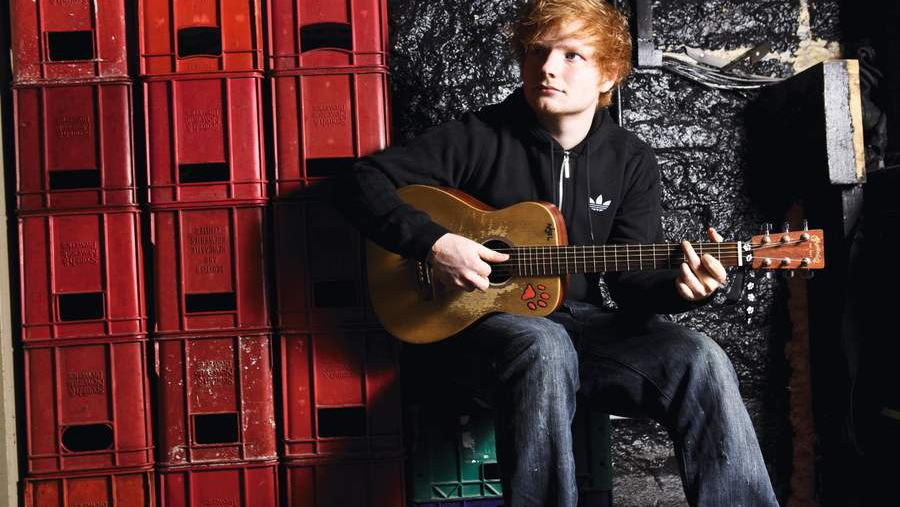
The acoustic guitar is one of the most accessible and rewarding instruments to learn. With the ability to be picked up and played just about anywhere and the capability to bring people together over a song, the acoustic guitar is a truly special instrument.
Now, whether you fancy yourself as a next-gen folk hero or simply a campfire strummer with an encyclopedic vocabulary of open chords, there has never been a better time to brush up on your unplugged chops.
Our carefully curated list of 25 acoustic guitar songs is designed to cater to players of all styles and skill levels. These tracks aren't all among the greatest acoustic guitar songs of all time, but they are stepping stones on your journey to becoming a better acoustic guitar player.
Perfect for beginners and intermediate players, they offer a great opportunity to practice and push your abilities. And to help you on your way, we've included some tips and tricks on how to master their sound.
1. Ed Sheeran - Tenerife Sea (from X, 2014)
This simple tune gets less love than some of Sheeran’s more obvious hits, but it stands out thanks to its lilting 6/8 rhythm and delicate fingerpicking.
Ed plays it with a capo on the 4th fret and the guitar tuned EADEBE, but early live performances show that it started out more simply, in standard tuning with a capo on the 1st fret.
Using that approach, you can play it using the Wonderwall trick of holding your third and fourth fingers down on the third fret (from the capo) on the first two strings throughout.
Get The Pick Newsletter
All the latest guitar news, interviews, lessons, reviews, deals and more, direct to your inbox!
The chords are G, A7sus4, Cadd9, Em7, and Dsus4. If Sheeran’s live performances are anything to go by, this should reduce your audience to uncontrollable sobbing and declarations of eternal love.
2. Bob Dylan - Blowin' In The Wind (from The Freewheelin’ Bob Dylan, 1963)
Maybe the most covered folk song of the 20th century, Blowin’ In The Wind pairs plaintive lyrics with a perfectly minimal guitar accompaniment.
The album version is played in D major with a capo on the 7th fret, though Dylan often performed it live in G, ditching the capo and moving to open position to make it easier to play.
The chords on the original are D, G and A (with a Gsus2/F# added in as a passing chord), but try to think in terms of the open chord shapes you’ll be using (G, C and D) – the shapes stay the same regardless of whether you’re using a capo.
Dylan nicely supplements the gentle strumming by picking out bass notes from the D major scale, which you can try once you’re confident with the chords.
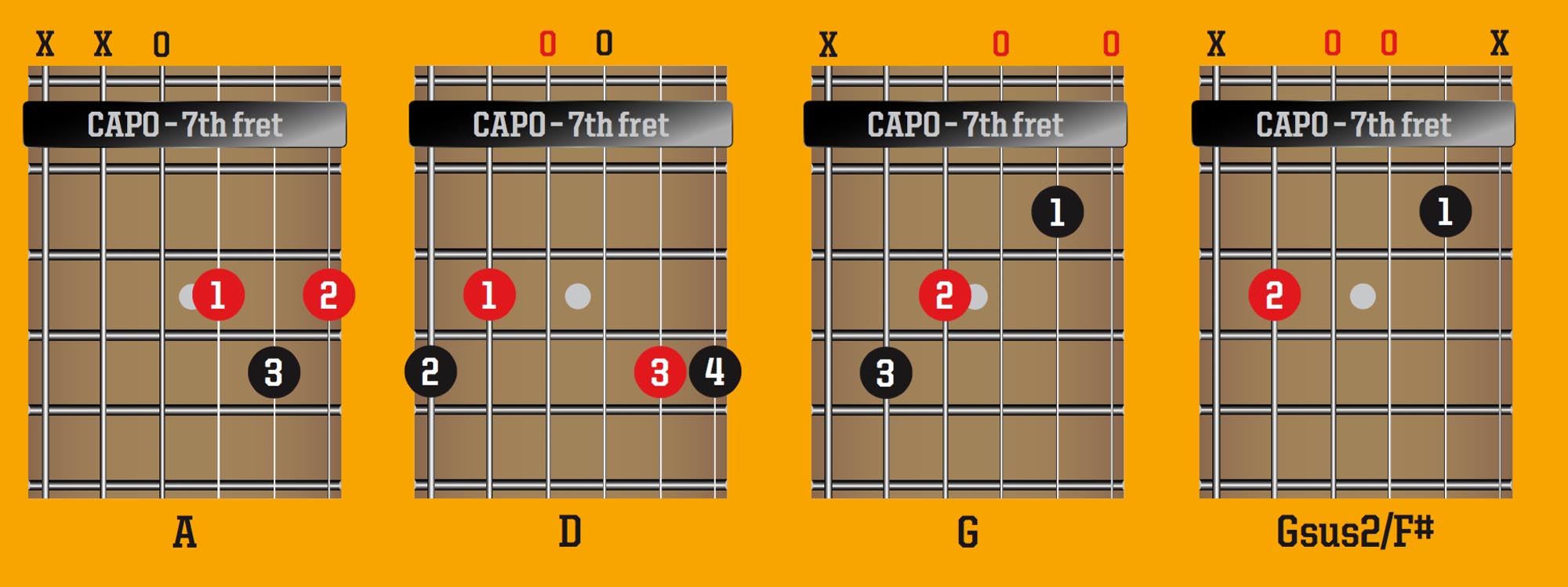
Our slowed down video starts halfway through the verse and leads you into the chorus, but there’s enough info to take you through most of the song.
3. The Beatles - Blackbird (from The Beatles, 1968)
McCartney’s deceptively simple magic is the perfect route into fingerstyle. Paul plucks with just his thumb and index finger, and the pattern stays consistent while the chords change – essentially just two-note shapes on the second and fifth strings with an open third string in between.
Blackbird is an ideal fingerstyle starter tune
When picking quickly between the second and third strings, Paul uses the pad of his index finger to create an upstroke on the third, and the nail to produce a downstroke on the second.
This technique sometimes catches additional strings, thickening the sound. Some tabs notate all those accidental plucks, making the pattern look more complicated than it really is.
They sound great, but they don’t need to be reproduced identically. Because you don’t have to play it with pinpoint accuracy, Blackbird is an ideal fingerstyle starter tune.
4. Led Zeppelin - Bron-Y-Aur Stomp (from Led Zeppelin III, 1970)
The world of 1970 was amazed to discover the band credited by some with inventing heavy metal were an impressive folk outfit, and your friends will be similarly amazed if you can nail Page’s intro.
After strummed harmonics and a mixture of hybrid picked and flatpicked pyrotechnics, the song settles into a signature riff that’s easy and fun to play. To play it, you’ll need to tune down to Open F (CFCFAC). Because it’s an open tuning, you can play full chords simply by barring the first five strings.
Because it’s an open tuning, you can play full chords simply by barring the first five strings
It begins with the open strings and a down-down-up-down-up strumming pattern, before barring the 3rd fret and then the 5th, with two strums on each. Try to stamp your foot to get the groove – it hasn’t got ‘stomp’ in the name for nothing!
5. Joni Mitchell - Big Yellow Taxi (from Ladies Of The Canyon, 1970)
Mitchell’s signature tune encapsulates great singer-songwriting: a simple chord structure becomes a classic thanks to creative rhythm and melody alongside insightful lyrics.
The chords are A, B, and E, with embellishments. Tune to Open D (D A D F# A D), with a capo on the 2nd fret. Start by barring all six strings at the 7th fret.
For the embellishment, add your third finger on the 9th fret of the fifth string. This looks like an E-shape minor 7 barre in standard tuning, but here it creates an A6 chord. Do the same thing two frets higher for the B. The E is simply all the strings played open.
To embellish it, use a shape that looks like an E7 chord: first finger on first fret (above the capo), third string, and second finger on 2nd fret, fifth string. Then add your third finger to fifth string, third fret, and alternate between these shapes and the open strings.
6. Ben Howard - Only Love (from Every Kingdom, 2011)
Known for his idiosyncratic ‘pick and go’ technique and his love of unusual tunings, Howard is one of the brightest young faces of British guitar. This song uses a fairly extreme A# F C G G C tuning, and if you plan to use this regularly you might find your guitar needs a change of string gauge or truss rod adjustment.
If you want to stay in standard tuning, you can cover Only Love with a capo on the 1st fret. Play Em-G for the verse, and Em-D-G-C for the chorus. This will do a great job supporting the melody, even if it lacks the depth of Howard’s original voicings.
7. Tracy Chapman - Fast Car (from Tracy Chapman, 1988)
There aren’t many acoustic songs to match Fast Car as an enduring radio classic. Chapman’s lyrics are part yearning for a different life and part nostalgia, and her guitar part evokes both.
The song only has four chords, and much of the interest comes from the dynamics, so vary your attack. The progression goes C-G-Em-D everywhere except the end of the chorus (“I had a feeling that I belonged...”) where it omits the G.
That addictive intro is played by lifting the first finger on the C to make a C major 7. G is played open, but Em is played with first finger on the fifth string at the 7th fret, and 8th fret on the second string (use any comfortable finger).
Pluck the open third string in between them for a spacious, wide-sounding chord. The D is open D and G strings and 7th fret B string – so technically a Dadd11.
8. Johnny Cash - Hurt (from American IV: The Man Comes Around, 2002)
If you can watch the video for Hurt and remain unmoved, you might be made of concrete. In Cash’s hands, Trent Reznor’s tortured song about addiction becomes a powerful meditation on life and death.
The intro and verse run through a simple Am-C-D progression played as arpeggios. We’ve played through this section in our slowed down video so you can see which strings to pick out. In the original recording, a piano plays a constant high G through the chorus – an effective harmonic trick to tie the whole thing together.
You can replicate this by keeping your fourth finger on G (first string, 3rd fret) while strumming the chorus chords, which are Am-F-C-G (sometimes omitting C). Playing the chords isn’t too hard. Whether you can capture its enormous weight of emotion is another matter.

9. Bob Marley - Redemption Song (from Uprising, 1980)
This ode to freedom, with its powerful reference to the legacy of slavery (“Old pirates yes they rob I/ Sold I to the merchant ships”) sounds strikingly relevant in 2020.
A departure for Marley, the song doesn’t feature his usual reggae rhythms. Instead, it begins with a melody based on the open position G major scale. The verse chords are G-Em-C-Am, then G-Em-C-D7.
The chorus alternates between G-C-D and Em-C-D. Finally, Bob’s instrumental riff after the chorus goes Em-C-D7. He lifts his fretting hand fingers on and off while strumming Em to create more movement in that section.
10. Stevie Ray Vaughan - Life By The Drop (from The Sky Is Crying, 1991)
If you love the blues but are tired of overused 12-bar progressions, Life By The Drop is for you. Stevie’s blues scale licks and use of the classic Robert Johnson A5-A6 riff make it unmistakably a blues song, but it features chord sequences more at home in great pop songs.
Stevie’s 12-string fattens the sound but it works well on a standard six-string too. Like all SRV recordings, it’s tuned down a semitone. The verses go A, E, F#m, D, while the chorus moves to F#m, D and E.
On the open chords in the verse, you can play an open position A5 powerchord and then add the 6th interval with your third finger two frets higher.
11. Extreme - Hole Hearted (from Pornograffitti, 1990)
You might have been expecting a different Extreme song here, but for our money Hole Hearted is the band’s acoustic showcase, even outclassing the more virtuosic Midnight Express for the sheer energy in the performances.
Nuno Bettencourt’s slide lines, blues riffs, and rhythm playing are all outstanding. The intro figure is played by strumming a humble open D shape before sliding it up two frets and then a further fret.
Following the intricate riffing in the verse, this sliding D shape recurs in the pre-chorus, this time up to A/D and G/D chords at the 9th and 7th frets – with the open fourth string still ringing out.
Just remember that you’ll need to tune to Eb, with all your strings down one semitone to play along with the recording.
12. Neil Young - The Needle And The Damage Done (Harvest, 1972)
In 1997, legendary folk icon Neil Young cancelled a tour after slicing off his fingertip while making lunch. The wags on TG’s editorial team ran the headline “The sandwich and the damage done”, proving we have always been as witty as we are educational!
You will indeed need all of your fingertips for this number, which features a whopping nine chords.
Most of them are easy, but F, Gm, and Bb all put in appearances, giving your barring finger a workout. It’s worth it though, with Young as always packing a great deal of emotion into just four verses.
The rest of the sequence is based around open D, C, and E chords with a few sus embellishments.
13. Pink Floyd - Wish You Were Here (from Wish You Were Here, 1975)
One of the ultimate campfire strummers, Wish You Were Here’s unforgettable intro makes a great solo piece or a backdrop for pentatonic improvisation.
The intro works by holding the high E and B strings at the 3rd fret throughout, with the bass notes changing underneath. It starts on Em7 before moving to G, back to Em7, then to A7sus4 and finishes on G, with passing phrases from the open E minor pentatonic scale.
Play each chord by starting on the root note (if you’re unsure, just play the lowest note), and then strum down-down-up to get the right feel. Our video takes you slowly through the intro.
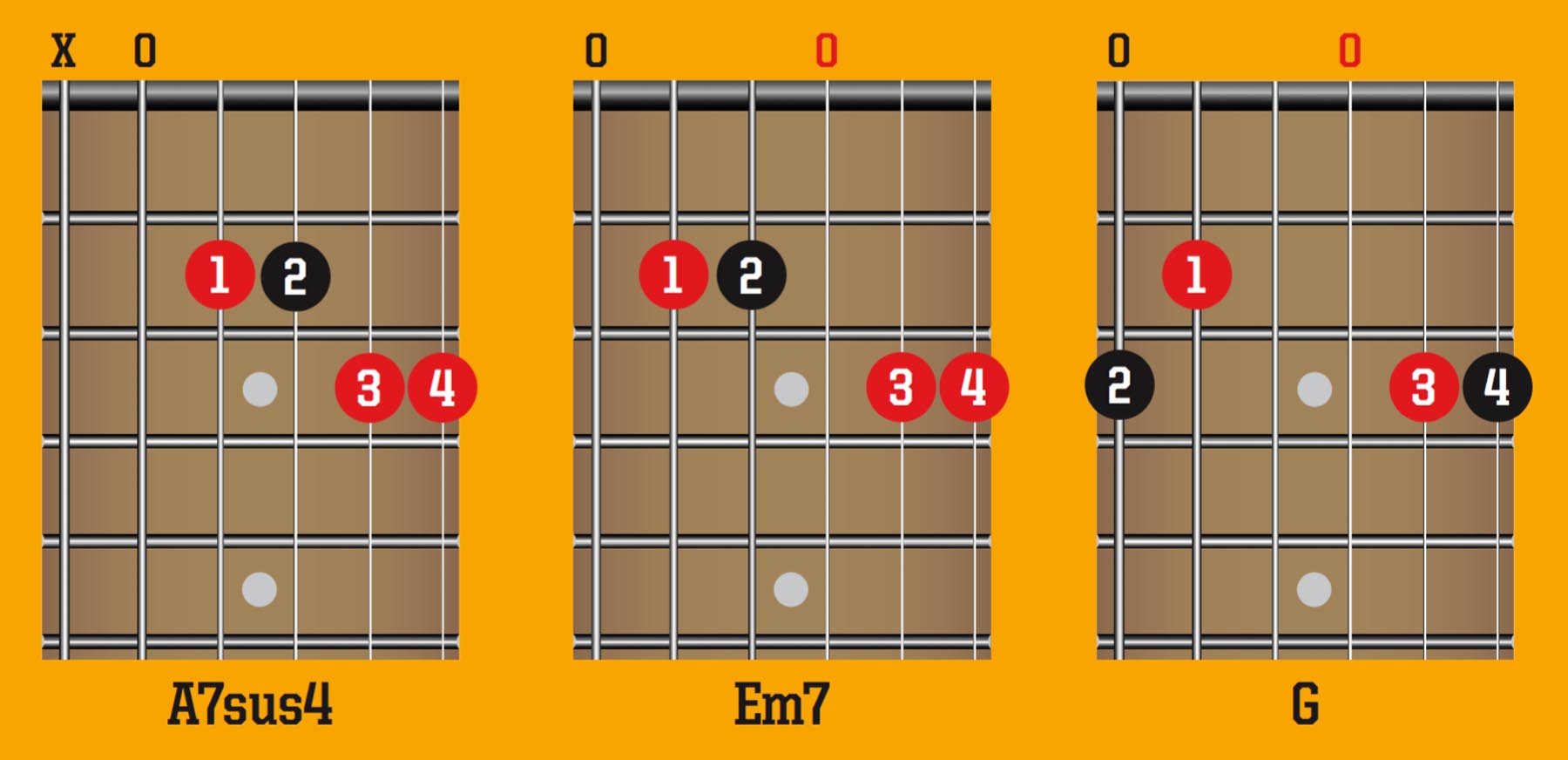
14. Nirvana - The Man Who Sold The World (from MTV Unplugged In New York, 1994)
Kurt’s MTV Unplugged Martin D-18E guitar recently sold for $6m, smashing the record price for a guitar at auction. Its reputation is largely because of this song. Reportedly, Kurt refused to do an encore after playing it, insisting there was no way he could top the band’s Bowie cover.
The intro melody is all on the third string, starting on the 2nd fret (2-2-2-0-2-3-2-0), and, despite being played on acoustic, routed through a Boss DS-2 Turbo Distortion pedal. The clean verse chords include A, Dm, F and C, while the chorus introduces a Db.
David Bowie said he was blown away by Nirvana’s cover, so it’s well worth getting to grips with those barre chords.
15. Robert Johnson - Crossroad Blues (1936)
Almost single-handedly defining the Delta blues genre, Johnson’s Crossroad Blues helped cement modern blues vocabulary.
For a more authentic sound, tune to open G (DGDGBD) and place a capo on the 3rd fret
Although his version didn’t use a straightforward 12-bar pattern, it does use the classic I-IV-I-V-IV-I chord progression often found in blues songwriting. His slide playing, learned from Mississippi innovator Son House, remains stunning.
If you’re in standard tuning, put a capo on the first fret to play along with the most famous early recording, and play a 12- bar blues in A (I is A7, IV is D7 and V is E7). For a more authentic sound, tune to open G (DGDGBD) and place a capo on the 3rd fret.
The first chord is Bb with the open strings (or 12 frets higher); the next chord is Eb, five frets above the capo. The other chord, F, is two frets higher again. If you have a slide, just experiment with it in each of those areas. Because you’re tuned to a chord, most notes will sound good!
16. Angel Olsen - Unf*cktheworld (from Burn Your Fire For No Witness, 2014)
Strictly speaking, this track is not an acoustic song, and Angel has been spied playing this song on a dual-humbucker Fender Stratocaster, a Silvertone 1381 and a Gibson S-1. But the vibe is pure folk and, we’d argue, Unf*cktheworld is a prime candidate for acoustic guitar.
And how to play it? Well, it’s just three easy chords: F and G, followed by occasional C chords. Easy, then! Angel plays these chords with gentle thumb-strumming, and it’s all downstrokes. Sometimes simple is best.
17. Nick Drake - Pink Moon (from Pink Moon, 1972)
While you could play a version of Pink Moon in standard tuning, Drake went to great lengths to discover unique tunings that expressed the sounds in his head.
It’s well worth tuning to his CGCFCE to get the sound of this tune, adding a capo on the 2nd fret. If you can play a full barre, it’s reasonably easy in this tuning.
The opening chord is all open strings except for the third string, 2nd fret. This 2nd-fret finger then skips onto the fourth string and then the fifth.
Next barre the 7th fret, and fret the third string 9th fret with your third finger. Holding the barre, add your fourth finger to the 9th fret second string, and remove your third finger. You repeat those two shapes two frets lower, before moving back up.
18. Elizabeth Cotten - Freight Train (from Folk Songs And Instrumentals With Guitar, 1958)
For years, this blues standard was credited to two white Englishmen, when in fact it was written by Elizabeth as a young teenager. Her version is tough to imitate because, like Hendrix, she played left handed using an upside-down guitar.
As a result, her fingerstyle approach, known as ‘Cotten picking’, used her thumb for the melody notes and fingers for the bass notes.
Part of the magic is that the chords change at irregular intervals, so you’ll need to listen for the changes, but the chords themselves are straightforward: C, G, G7, E7 and F all make appearances.
You can create an effective fingerstyle arrangement by picking the sixth string on beats 1 and 3, and the fourth string on beats 2 and 4, leaving your fingers to pick out the melody.
19. Lindsey Buckingham - Not Too Late (from Under The Skin, 2006)
At first listen, Lindsey Buckingham’s rapid-fire fingerstyle lines sound near impossible to play.
In fact, there are just three main chord shapes (Dmadd9, Bbadd9 and Cadd9), and the picking is a repeating pattern – so it’s easy to gradually build speed.
You may not recognise the shapes; Lindsey’s playing in open F tuning (CFCFAC) here – but they’re all fairly easy barre chords. The fingerpicking is the real challenge due to its ferocious speed.
Your thumb alternates between the fourth and fifth strings, and your first, second and third fingers cover the third, second and first strings respectively. Watch the video to pick up on the details.
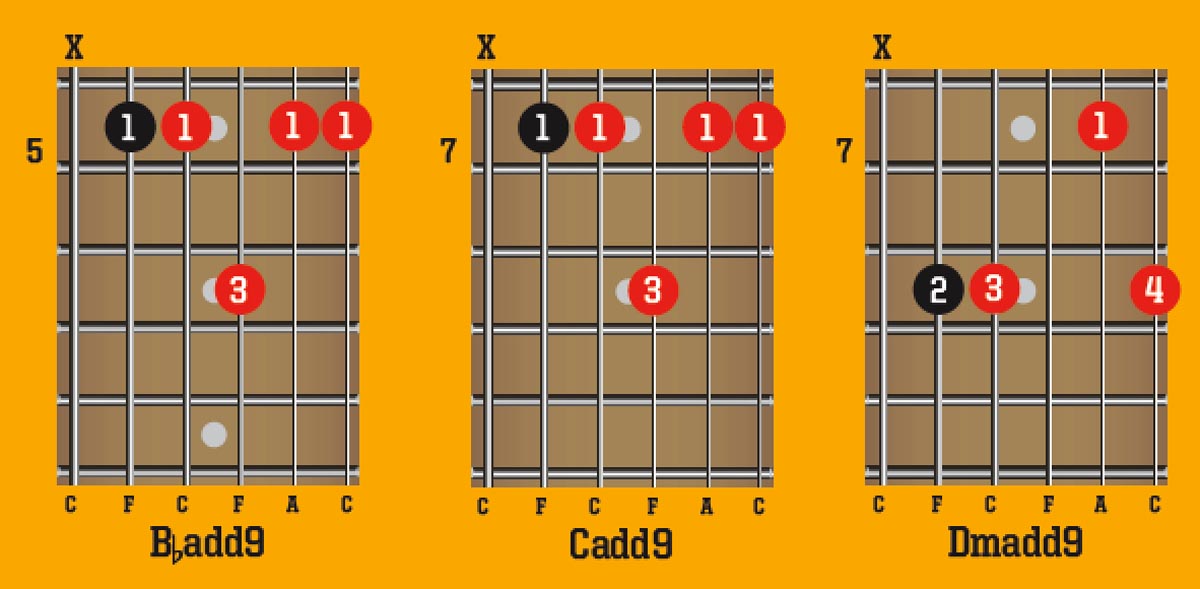
20. Simon & Garfunkel - The Boxer (from Bridge Over Troubled Water, 1970)
It’s easier than it sounds, but if you can play this convincingly, you’ll impress everyone. Although there are simpler fingerpicking patterns than Paul Simon’s, The Boxer rarely asks you to pick more than one string at a time, which in that respect makes it easier than Blackbird or Freight Train.
You don’t need to perfectly copy his pattern either; as long as you hit the root note on beat 1 of the bar and keep a steady flow of eighth notes, you can improvise freely.
The (somewhat simplified) verse chord sequence is C-Am-G-C, Am-G-F-C, C-G, while the “la-la-lie” section goes Am-Em- Am-G. All that remains is to find someone to sing Art Garfunkel’s vocal line.
21. Newton Faulkner - Teardrop (from Handbuilt By Robots, 2007)
Faulkner brought the percussive tap’n’slap acoustic style of players like Eric Roche, Preston Reed and Michael Hedges into the mainstream in 2007, and this reworking of a Massive Attack classic is a great place to learn it.
You create the ‘kick drum’ sounds by thumping the heel of your hand above the soundhole, and the ‘snare’ sounds by tapping your fingernails below the soundhole (a plugged-in electro-acoustic with some reverb makes this more effective).
The chords are simply D, C, and G. Newton tunes to DGDGAD, and implies the chords with root notes: D on the open fourth string, C on the fifth string, 5th fret, and G on the open fifth string. The melody is played by hammering on the first string at the 5th and 7th frets, with open strings in between.
Individually, each part is a doddle. Putting it all together is a different beast, however...
22. John Martyn - May You Never (from Bless The Weather, 1971)
Martyn was a titan of acoustic guitar and this song sounds formidable, so you might be surprised to learn it has just three main chords under the hood: D, G/B, and A.
Tune your guitar to drop D (DADGBE) and capo the 2nd fret for the full effect. If you’re now strumming those chords with a disappointed expression wondering it doesn’t sound like John Martyn, you’re some way to recognising his brilliance.
To get close to his sound, try this move: play the A chord as a first finger barre, then add your second finger on the second string 3rd fret and your third finger on the fourth string 4th fret, creating D/A. Finally, add your fourth finger on the fourth string 5th fret, creating an A7sus4.
This bluesy sequence appears regularly throughout.
23. Dire Straits - Romeo & Juliet (from Making Movies, 1980)
An all-time acoustic classic, Romeo And Juliet is played by Dire Straits singer/songwriter/guitarist Mark Knopfler on his open G-tuned resonator with a capo on the 3rd fret.
It’s intricate, no doubt, but get the tuning right (DGDGBD) and there are really only three chords to learn: F, C and Bb – and the Bb is all open strings!
If you’re not all that keen on fingerpicking, it’s surprising how far you can get just strumming these shapes. Make the move from strumming to fingerstyle by outlining the beat on the root notes with your thumb and randomly picking some treble notes until you start to get a feel for the timing.
Hint. There’s a light swing feel here, except on the six-string arpeggio – which reverts to a straight feel. Hear Knopfler’s intro played slowly in our video.
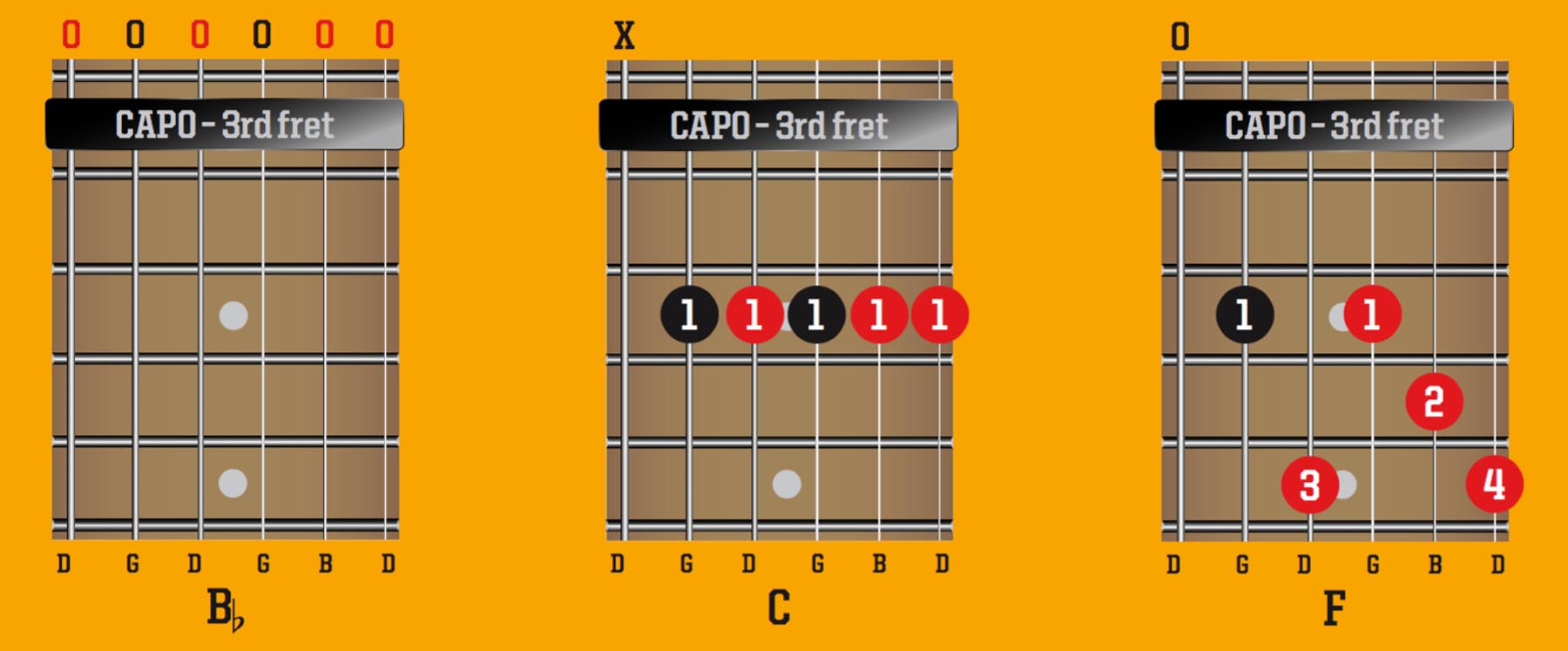
24. The Rolling Stones - You Got The Silver (from Let It Bleed, 1969)
Slide guitar may strike fear in the hearts of first-timers, but the intro to this open D-tuned (D A D F# A D) Rolling Stones acoustic classic isn’t too challenging.
If you’re seeking out tabs online for an authentic rendition, we recommend placing your slide on your fourth finger – this allows you to fret the standard ‘non-slide’ chord shapes with your first three digits.
In later years, Ronnie Wood has played it live with a slide on his second finger, but he’s reinterpreted Keith’s original parts in the process – some of those chords are unplayable with Ronnie’s method.
The main part of the riff is just a matter of alternating between the 5th fret (with your slide) and the open strings.
25. Oasis - Half The World Away (1994)
We’ve already mentioned Oasis’ biggest acoustic song, Wonderwall, so we thought we’d choose another influential tune, this time sung by Noel Gallagher.
Though a non-album track, Half The World Away has garnered popular appeal as the theme tune to the BBC sitcom The Royle Family and in Christmas TV ads for John Lewis. Okay, the credibility might be stretched, but it’s a great song nonetheless.
Though based around chords in the key of C major (C, F, Em, Am, G and G7), you’ll also need to watch out for a few chords from outside the key: D, E7 and Fm all appear briefly.
Explore more acoustic gear...
- Just starting out? Explore the best acoustic guitars for beginners
- On a budget? These are the 9 best acoustic guitars under $500
- The best acoustic guitars for any budget
- Freshen up your tone with the best acoustic guitar strings
Total Guitar is one of Europe's biggest guitar magazines. With lessons to suit players of all levels, TG's world-class tuition is friendly, accessible and jargon-free, whether you want to brush up on your technique or improve your music theory knowledge. We also talk to the biggest names in the world of guitar – from interviews with all-time greats like Brian May and Eddie Van Halen to our behind the scenes Rig Tour features, we get you up close with the guitarists that matter to you.





























